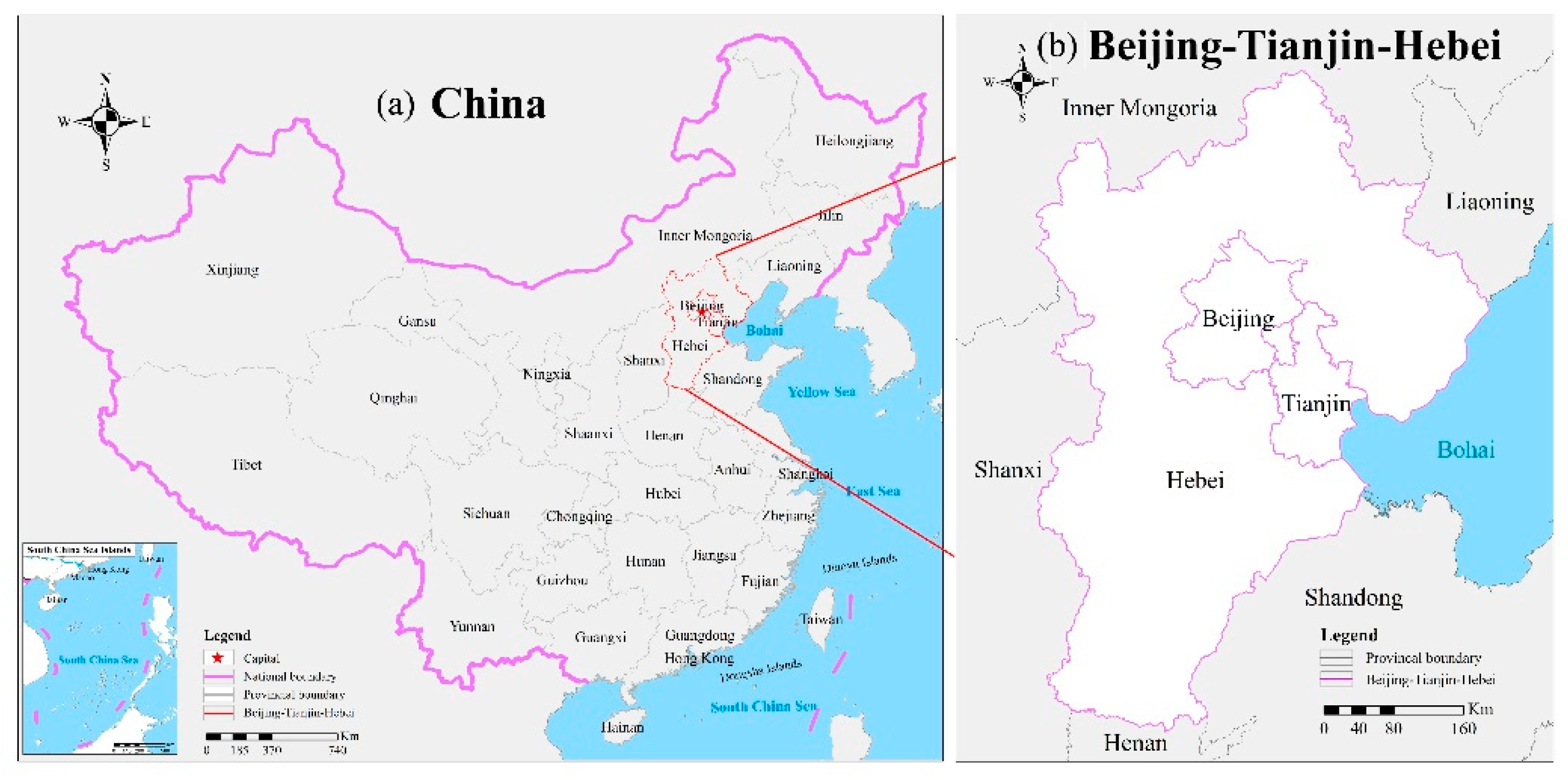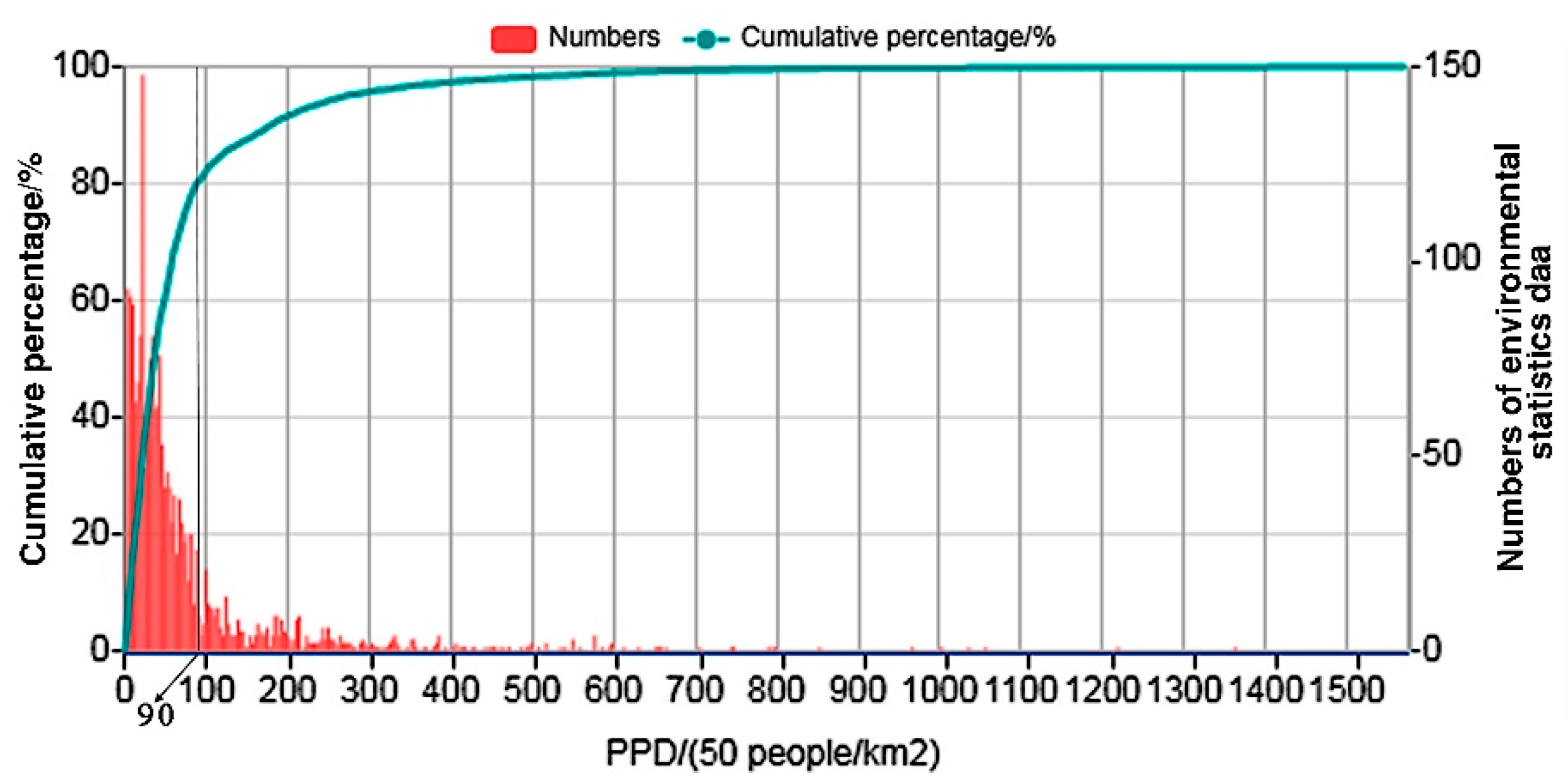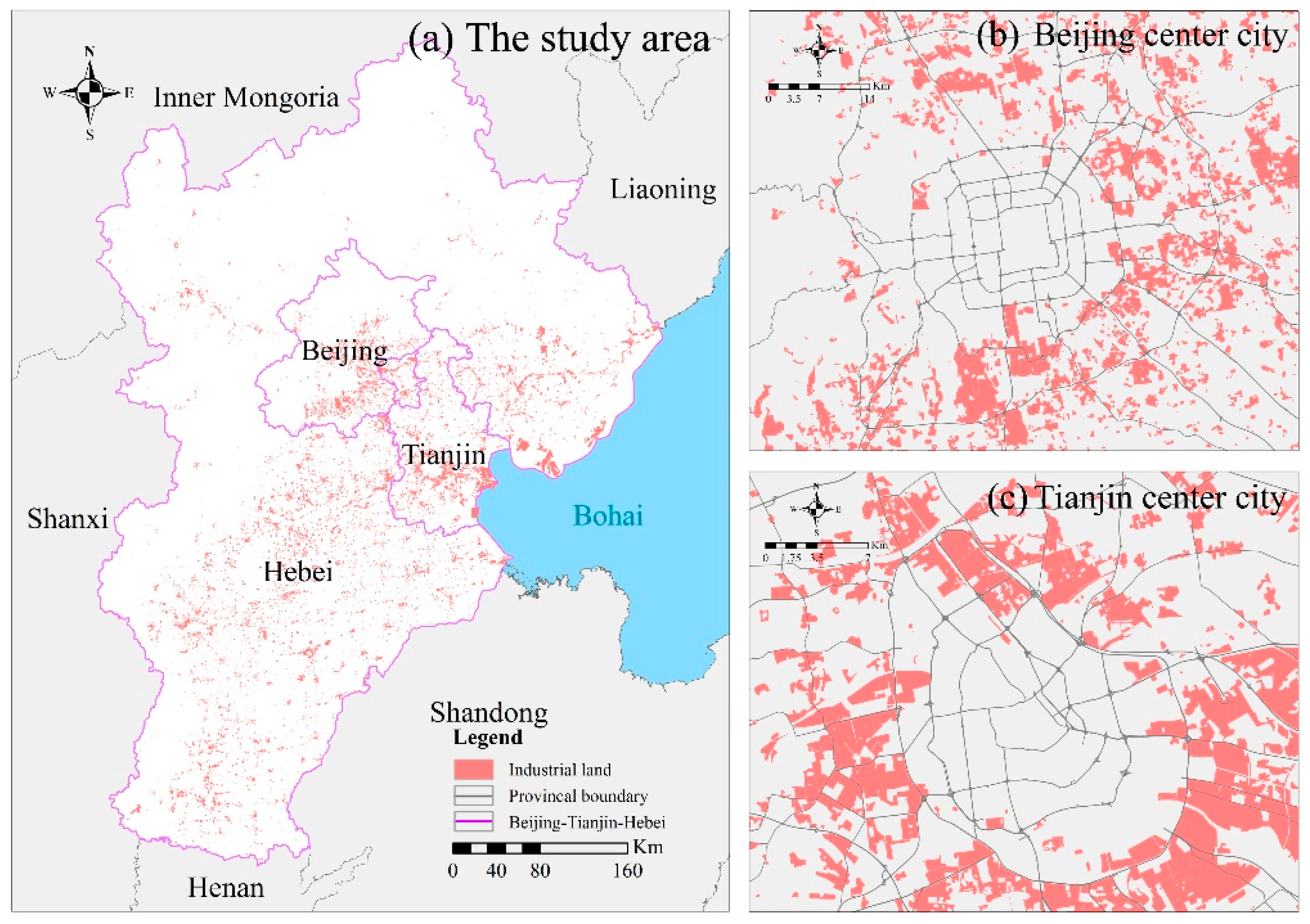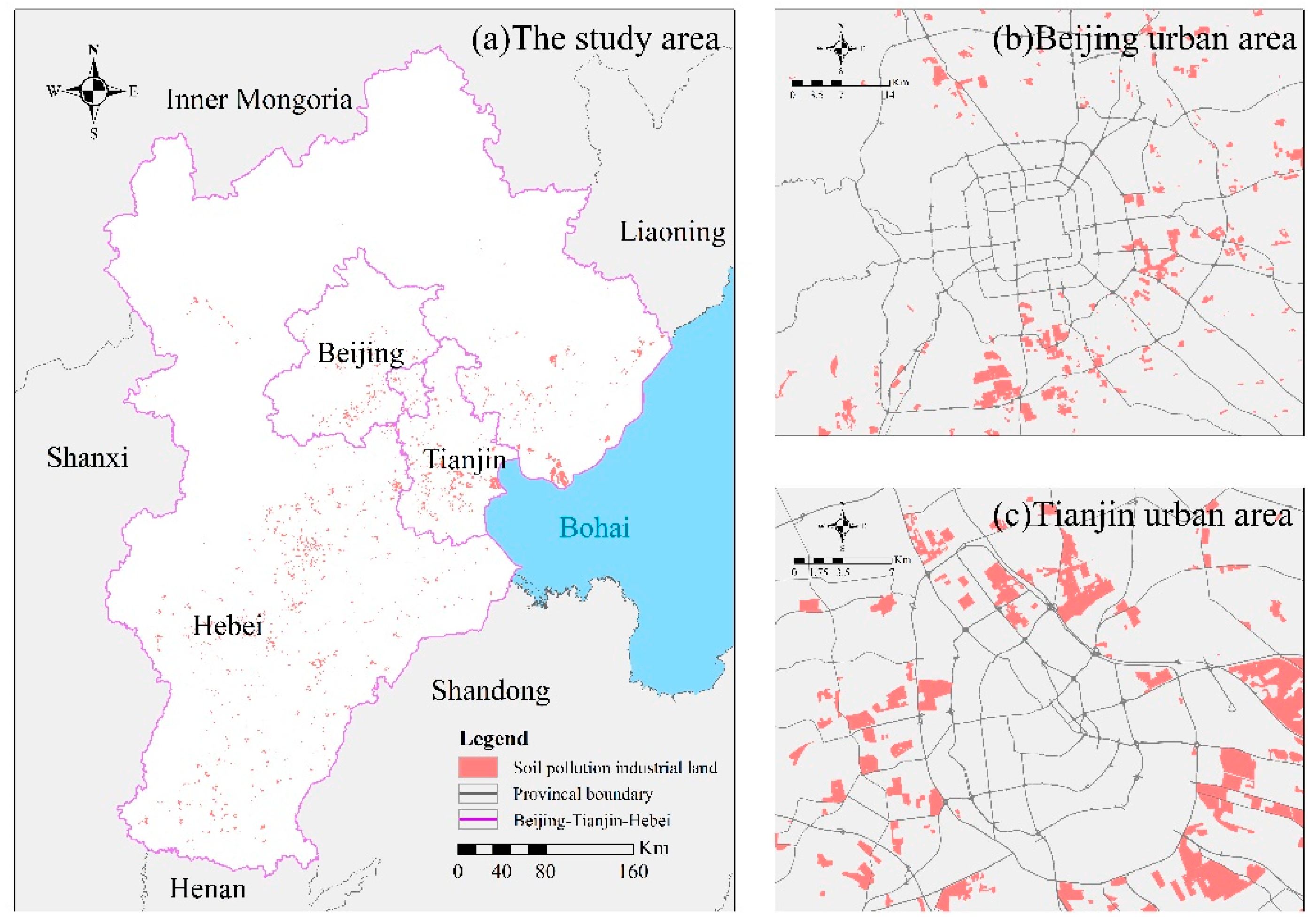Identification of Industrial Land Parcels and Its Implications for Environmental Risk Management in the Beijing–Tianjin–Hebei Urban Agglomeration
Abstract
1. Introduction
2. Orientation on Industrial Land Parcels and Environmental Risks
3. Materials and Methods
3.1. Study Area
3.2. Main Components
3.3. Data Preparation and Analysis
3.3.1. POIs and Cleaning
3.3.2. OpenStreetMap and Processing
3.3.3. Land Use and Built-Up Land Parcel Analysis
3.3.4. Parcel Population Density Analysis
3.3.5. Other Datasets
3.4. Validation
4. Results
4.1. The Industrial Enterprise POIs after Cleaning and Classifications
4.2. Identifying the Possible Industrial Land Parcels
4.3. The PPD Threshold of the Industrial Land Parcels
4.4. Identifying the Industrial Land Parcels Using POIs
4.5. Validating Results
5. Discussion
5.1. Distinguishing the Land Parcels with Human Settlement Risks
5.2. Screening Soil Contamination Risk in Industrial Parcels
5.3. Uncertainty and Disadvantages
6. Conclusions
6.1. Main Conclusions
6.2. Policy Implications
Author Contributions
Funding
Acknowledgments
Conflicts of Interest
References
- Wang, Q.; Tapia Granados, J.A. Economic growth and mental health in 21st century China. Soc. Sci. Med. 2019, 220, 387–395. [Google Scholar] [CrossRef] [PubMed]
- Song, M.; Peng, J.; Wang, J.; Zhao, J. Environmental efficiency and economic growth of China: A Ray slack-based model analysis. Eur. J. Oper. Res. 2018, 269, 51–63. [Google Scholar] [CrossRef]
- Cui, X.; Fang, C.; Liu, H.; Liu, X. Assessing sustainability of urbanization by a coordinated development index for an Urbanization-Resources-Environment complex system: A case study of Jing-Jin-Ji region, China. Ecol. Indic. 2019, 96, 383–391. [Google Scholar] [CrossRef]
- Ye, C.; Chen, M.; Duan, J.; Yang, D. Uneven development, urbanization and production of space in the middle-scale region based on the case of Jiangsu province, China. Habitat Int. 2017, 66, 106–116. [Google Scholar] [CrossRef]
- Wang, J.; Lin, Y.; Glendinning, A.; Xu, Y. Land-use changes and land policies evolution in China’s urbanization processes. Land Use Policy 2018, 75, 375–387. [Google Scholar] [CrossRef]
- Zhao, H.; Guo, S.; Zhao, H. Characterizing the Influences of Economic Development, Energy Consumption, Urbanization, Industrialization, and Vehicles Amount on PM2.5 Concentrations of China. Sustainability 2018, 10, 2574. [Google Scholar] [CrossRef]
- Wang, S.; Zhou, C.; Li, G.; Feng, K. CO2, economic growth, and energy consumption in China’s provinces: Investigating the spatiotemporal and econometric characteristics of China’s CO2 emissions. Ecol. Indic. 2016, 69, 184–195. [Google Scholar] [CrossRef]
- Fu, G.; Wang, J.; Yan, M. Anatomy of Tianjin Port fire and explosion: Process and causes. Process Saf. Prog. 2016, 35, 216–220. [Google Scholar] [CrossRef]
- Chen, M.; Liu, W.; Lu, D. Challenges and the way forward in China’s new-type urbanization. Land Use Policy 2016, 55, 334–339. [Google Scholar] [CrossRef]
- Ma, L.; Li, M.; Ma, X.; Cheng, L.; Du, P.; Liu, Y. A review of supervised object-based land-cover image classification. ISPRS J. Photogramm. Remote Sens. 2017, 130, 277–293. [Google Scholar] [CrossRef]
- Sawant, S.S.; Prabukumar, M. A review on graph-based semi-supervised learning methods for hyperspectral image classification. Egypt. J. Remote Sens. Space Sci. 2018. [Google Scholar] [CrossRef]
- Ali, M.Z.; Qazi, W.; Aslam, N. A comparative study of ALOS-2 PALSAR and landsat-8 imagery for land cover classification using maximum likelihood classifier. Egypt. J. Remote Sens. Space Sci. 2018, 21, S29–S35. [Google Scholar] [CrossRef]
- Sinha, S.; Sharma, L.K.; Nathawat, M.S. Improved Land-use/Land-cover classification of semi-arid deciduous forest landscape using thermal remote sensing. Egypt. J. Remote Sens. Space Sci. 2015, 18, 217–233. [Google Scholar] [CrossRef]
- Long, Y.; Zhai, W.; Shen, Y.; Ye, X. Understanding uneven urban expansion with natural cities using open data. Landsc. Urban Plan. 2018, 177, 281–293. [Google Scholar] [CrossRef]
- Liu, X.; Long, Y. Automated identification and characterization of parcels with OpenStreetMap and points of interest. Environ. Plan. B Plan. Des. 2015, 43, 341–360. [Google Scholar] [CrossRef]
- Lang, W.; Long, Y.; Chen, T. Rediscovering Chinese cities through the lens of land-use patterns. Land Use Policy 2018, 79, 362–374. [Google Scholar] [CrossRef]
- Jiang, G.; Ma, W.; Wang, D.; Zhou, D.; Zhang, R.; Zhou, T. Identifying the internal structure evolution of urban built-up land sprawl (UBLS) from a composite structure perspective: A case study of the Beijing metropolitan area, China. Land Use Policy 2017, 62, 258–267. [Google Scholar]
- Zhang, W.; Li, W.; Zhang, C.; Hanink, D.M.; Liu, Y.; Zhai, R. Analyzing horizontal and vertical urban expansions in three East Asian megacities with the SS-coMCRF model. Landsc. Urban Plan. 2018, 177, 114–127. [Google Scholar] [CrossRef]
- Yang, Y.; Liu, Y.; Li, Y.; Du, G. Quantifying spatio-temporal patterns of urban expansion in Beijing during 1985–2013 with rural-urban development transformation. Land Use Policy 2018, 74, 220–230. [Google Scholar] [CrossRef]
- Zhang, Z.; Li, N.; Wang, X.; Liu, F.; Yang, L. A Comparative Study of Urban Expansion in Beijing, Tianjin and Tangshan from the 1970s to 2013. Remote Sens. 2016, 8, 496. [Google Scholar] [CrossRef]
- Bi, C.; Chen, Y.; Zhao, Z.; Li, Q.; Zhou, Q.; Ye, Z.; Ge, X. Characteristics, sources and health risks of toxic species (PCDD/Fs, PAHs and heavy metals) in PM2.5 during fall and winter in an industrial area. Chemosphere 2020, 238, 124620. [Google Scholar] [CrossRef] [PubMed]
- Zhang, Z.Y.; Shao, C.F.; Guan, Y.; Xue, C.Y. Socioeconomic factors and regional differences of PM2.5 health risks in China. J. Environ. Manag. 2019, 251, 10. [Google Scholar] [CrossRef] [PubMed]
- Zhang, W.; Li, W.; Zhang, C.; Hanink, D.M.; Li, X.; Wang, W. Parcel-based urban land use classification in megacity using airborne LiDAR, high resolution orthoimagery, and Google Street View. Comput. Environ. Urban Syst. 2017, 64, 215–228. [Google Scholar] [CrossRef]
- Wang, T.; Kazak, J.; Han, Q.; de Vries, B. A framework for path-dependent industrial land transition analysis using vector data. Eur. Plan. Stud. 2019, 27, 1391–1412. [Google Scholar] [CrossRef]
- Jiang, G.; Ma, W.; Qu, Y.; Zhang, R.; Zhou, D. How does sprawl differ across urban built-up land types in China? A spatial-temporal analysis of the Beijing metropolitan area using granted land parcel data. Cities 2016, 58, 1–9. [Google Scholar] [CrossRef]
- Sun, C.; Sun, C.; Yang, Z.; Zhang, J.; Deng, Y. Urban Land Development for Industrial and Commercial Use: A Case Study of Beijing. Sustainability 2016, 8, 1323. [Google Scholar] [CrossRef]
- Guan, Y.; Shao, C.; Gu, Q.; Ju, M.; Zhang, Q. Method for Assessing the Integrated Risk of Soil Pollution in Industrial and Mining Gathering Areas. Int. J. Environ. Res. Public Health 2015, 12, 14589–14609. [Google Scholar] [CrossRef]
- Liang, S.Y.; Cui, J.L.; Bi, X.Y.; Luo, X.S.; Li, X.D. Deciphering source contributions of trace metal contamination in urban soil, road dust, and foliar dust of Guangzhou, southern China. Sci. Total Environ. 2019, 695, 12. [Google Scholar] [CrossRef]
- Sun, Y.M.; Li, H.; Guo, G.L.; Semple, K.T.; Jones, K.C. Soil contamination in China: Current priorities, defining background levels and standards for heavy metals. J. Environ. Manag. 2019, 251, 7. [Google Scholar] [CrossRef]
- Huang, Y.Y.; Zhou, B.H.; Li, N.; Li, Y.M.; Han, R.R.; Qi, J.C.; Lu, X.H.; Li, S.; Feng, C.Y.; Liang, S. Spatial-temporal analysis of selected industrial aquatic heavy metal pollution in China. J. Clean. Prod. 2019, 238, 10. [Google Scholar] [CrossRef]
- Chen, L.; Wang, Y.M.; Li, P.W.; Ji, Y.Q.; Kong, S.F.; Li, Z.Y.; Bai, Z.P. A land use regression model incorporating data on industrial point source pollution. J. Environ. Sci. 2012, 24, 1251–1258. [Google Scholar] [CrossRef]
- Zhang, Q.; Zheng, Y.; Tong, D.; Shao, M.; Wang, S.; Zhang, Y.; Xu, X.; Wang, J.; He, H.; Liu, W.; et al. Drivers of improved PM2.5 air quality in China from 2013 to 2017. Proc. Natl. Acad. Sci. USA 2019, 116, 24463–24469. [Google Scholar] [CrossRef]
- Li, T.; Liu, Y.; Wang, C.; Olsson, G.; Wang, Z.; Wang, H. Decentralization of the non-capital functions of Beijing: Industrial relocation and its environmental effects. J. Clean. Prod. 2019, 224, 545–556. [Google Scholar] [CrossRef]
- Huang, H.B.; Chen, Y.L.; Clinton, N.; Wang, J.; Wang, X.Y.; Liu, C.X.; Gong, P.; Yang, J.; Bai, Y.Q.; Zheng, Y.M.; et al. Mapping major land cover dynamics in Beijing using all Landsat images in Google Earth Engine. Remote Sens. Environ. 2017, 202, 166–176. [Google Scholar] [CrossRef]
- Chen, C.R.; Du, Z.B.; Zhu, D.H.; Zhang, C.; Yang, J.Y. Land Use Classification in Construction Areas Based on Volunteered Geographic Information. In Proceedings of the IEEE 2016 Fifth International Conference on Agro-Geoinformatics, Tianjin, China, 18–20 July 2016; pp. 32–35. [Google Scholar]
- Jia, Y.; Ge, Y.; Ling, F.; Guo, X.; Wang, J.; Wang, L.; Chen, Y.; Li, X. Urban Land Use Mapping by Combining Remote Sensing Imagery and Mobile Phone Positioning Data. Remote Sens. 2018, 10, 446. [Google Scholar] [CrossRef]
- Wei, W.; Wang, X.; Zhu, H.; Li, J.; Zhou, S.; Zou, Z.; Li, J.S. Carbon emissions of urban power grid in Jing-Jin-Ji region: Characteristics and influential factors. J. Clean. Prod. 2017, 168, 428–440. [Google Scholar] [CrossRef]
- Wang, Y.; Liu, H.; Mao, G.; Zuo, J.; Ma, J. Inter-regional and sectoral linkage analysis of air pollution in Beijing–Tianjin–Hebei (Jing-Jin-Ji) urban agglomeration of China. J. Clean. Prod. 2017, 165, 1436–1444. [Google Scholar] [CrossRef]
- Zhao, D.; Tang, Y.; Liu, J.; Tillotson, M.R. Water footprint of Jing-Jin-Ji urban agglomeration in China. J. Clean. Prod. 2017, 167, 919–928. [Google Scholar] [CrossRef]
- Zhang, X.; Du, S.; Wang, Q. Hierarchical semantic cognition for urban functional zones with VHR satellite images and POI data. ISPRS J. Photogramm. Remote Sens. 2017, 132, 170–184. [Google Scholar] [CrossRef]
- Dong, R.; Li, S.; Zhang, Y.; Zhang, N.; Wang, T.; Tan, X.; Fu, X. Analysis of urban environmental problems based on big data from the urban municipal supervision and management information system. Ecol. Indic. 2018, 94, 52–69. [Google Scholar] [CrossRef]
- Zheng, S.; Zheng, J. Assessing the Completeness and Positional Accuracy of OpenStreetMap in China. In Thematic Cartography for the Society; Bandrova, T., Konecny, M., Zlatanova, S., Eds.; Springer International Publishing: Cham, Switzerland, 2014; pp. 171–189. [Google Scholar]
- Liu, J.; Kuang, W.; Zhang, Z.; Xu, X.; Qin, Y.; Ning, J.; Zhou, W.; Zhang, S.; Li, R.; Yan, C.; et al. Spatiotemporal characteristics, patterns, and causes of land-use changes in China since the late 1980s. J. Geogr. Sci. 2014, 24, 195–210. [Google Scholar] [CrossRef]
- Ning, J.; Liu, J.; Kuang, W.; Xu, X.; Zhang, S.; Yan, C.; Li, R.; Wu, S.; Hu, Y.; Du, G.; et al. Spatiotemporal patterns and characteristics of land-use change in China during 2010–2015. J. Geogr. Sci. 2018, 28, 547–562. [Google Scholar] [CrossRef]
- Azar, D.; Engstrom, R.; Graesser, J.; Comenetz, J. Generation of fine-scale population layers using multi-resolution satellite imagery and geospatial data. Remote Sens. Environ. 2013, 130, 219–232. [Google Scholar] [CrossRef]
- Leyk, S.; Gaughan, A.E.; Adamo, S.B.; de Sherbinin, A.; Balk, D.; Freire, S.; Rose, A.; Stevens, F.R.; Blankespoor, B.; Frye, C.; et al. The spatial allocation of population: A review of large-scale gridded population data products and their fitness for use. Earth Syst. Sci. Data 2019, 11, 1385–1409. [Google Scholar] [CrossRef]
- Zhao, Y.; Gong, P.; Yu, L.; Hu, L.; Li, X.; Li, C.; Zhang, H.; Zheng, Y.; Wang, J.; Zhao, Y.; et al. Towards a common validation sample set for global land-cover mapping. Int. J. Remote Sens. 2014, 35, 4795–4814. [Google Scholar] [CrossRef]
- Madugundu, R. Detection of Land Use and Land Cover Changes in Dirab Region of Saudi Arabia Using Remotely Sensed Imageries. Am. J. Environ. Sci. 2014, 10, 8–18. [Google Scholar] [CrossRef]
- Meng, Y.; Yan, X.; Zhao, D.; Mannan, M.S. Challenges and reflections on the development of urban refineries in China. J. Loss Prev. Process Ind. 2018, 56, 1–9. [Google Scholar] [CrossRef]
- Liu, L.; Li, W.; Song, W.; Guo, M. Remediation techniques for heavy metal-contaminated soils: Principles and applicability. Sci. Total Environ. 2018, 633, 206–219. [Google Scholar] [CrossRef]
- Wu, Q.; Zhang, X.; Liu, C.; Chen, Z. The de-industrialization, re-suburbanization and health risks of brownfield land reuse: Case study of a toxic soil event in Changzhou, China. Land Use Policy 2018, 74, 187–194. [Google Scholar] [CrossRef]
- Bright, J.; De Sabbata, S.; Lee, S.; Ganesh, B.; Humphreys, D.K. OpenStreetMap data for alcohol research: Reliability assessment and quality indicators. Health Place 2018, 50, 130–136. [Google Scholar] [CrossRef]
- Zhang, Y.; Li, X.; Wang, A.; Bao, T.; Tian, S. Density and diversity of OpenStreetMap road networks in China. J. Urban Manag. 2015, 4, 135–146. [Google Scholar] [CrossRef]
- Peng, W.; Wang, G.; Zhou, J.; Zhao, J.; Yang, C. Studies on the temporal and spatial variations of urban expansion in Chengdu, western China, from 1978 to 2010. Sustain. Cities Soc. 2015, 17, 141–150. [Google Scholar] [CrossRef]
- Zhang, Z.; Wang, X.; Zhao, X.; Liu, B.; Yi, L.; Zuo, L.; Wen, Q.; Liu, F.; Xu, J.; Hu, S. A 2010 update of National Land Use/Cover Database of China at 1:100,000 scale using medium spatial resolution satellite images. Remote Sens. Environ. 2014, 149, 142–154. [Google Scholar] [CrossRef]







| Types | Title 2 | Descriptions |
|---|---|---|
| POIs of Polluting enterprises | Human settlement risks | The enterprises with potential environmental risks (flammable or explosive) such as chemical, firecracker, and petroleum enterprises, etc. |
| Soil pollution | The enterprises with soil contamination risk which mainly include ferrous metal mine mining and processing industry, textile industry, paper industry, metal manufacturing, etc. | |
| Other pollutions | The enterprises might cause other pollutants, such as electricity generation, plastics industry, food processing, clothing manufacturing, cement manufacturing, etc. | |
| POIs of Residences | The POIs that mainly represent residential parcels. | |
| Provinces | Numbers of Polluting Enterprise POIs | Numbers of Polluting Enterprise POIs in Built-Up Land Parcel | Percent/% |
|---|---|---|---|
| Beijing | 22,288 | 20,394 | 91.5 |
| Tianjin | 18,903 | 17,235 | 91.2 |
| Hebei | 56,496 | 47,015 | 83.2 |
| Total | 97,687 | 84,644 | 86.6 |
| Provinces | Numbers of Environmental Statistics Data | Numbers of Environmental Statistics Data in Developed Parcels | Percent/% |
|---|---|---|---|
| Beijing | 843 | 786 | 93.2 |
| Tianjin | 2015 | 1887 | 93.6 |
| Hebei | 6081 | 3632 | 59.7 |
| Total | 8939 | 6305 | 70.5 |
© 2019 by the authors. Licensee MDPI, Basel, Switzerland. This article is an open access article distributed under the terms and conditions of the Creative Commons Attribution (CC BY) license (http://creativecommons.org/licenses/by/4.0/).
Share and Cite
Wang, Z.; Zhao, J.; Lin, S.; Liu, Y. Identification of Industrial Land Parcels and Its Implications for Environmental Risk Management in the Beijing–Tianjin–Hebei Urban Agglomeration. Sustainability 2020, 12, 174. https://doi.org/10.3390/su12010174
Wang Z, Zhao J, Lin S, Liu Y. Identification of Industrial Land Parcels and Its Implications for Environmental Risk Management in the Beijing–Tianjin–Hebei Urban Agglomeration. Sustainability. 2020; 12(1):174. https://doi.org/10.3390/su12010174
Chicago/Turabian StyleWang, Zishu, Jie Zhao, Sijie Lin, and Yi Liu. 2020. "Identification of Industrial Land Parcels and Its Implications for Environmental Risk Management in the Beijing–Tianjin–Hebei Urban Agglomeration" Sustainability 12, no. 1: 174. https://doi.org/10.3390/su12010174
APA StyleWang, Z., Zhao, J., Lin, S., & Liu, Y. (2020). Identification of Industrial Land Parcels and Its Implications for Environmental Risk Management in the Beijing–Tianjin–Hebei Urban Agglomeration. Sustainability, 12(1), 174. https://doi.org/10.3390/su12010174




